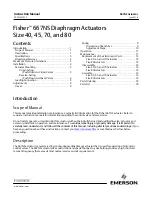
Instruction Manual
D102603X012
667NS Actuator
June 2018
13
6. Install three new O‐rings (keys 8 and 9) on the seal bushing.
7. Lubricate the O‐rings, and fill the seal bushing with lithium grease (key 99) or high‐temperature, radiation‐resistant,
polyphenyl ether grease (key 100), as appropriate to the installation and install the bushing in the top of the
actuator yoke assembly (key 73). Secure with the snap ring.
8. Coat a new gasket (key 70) with lithium grease (key 99) or high‐temperature, radiation‐resistant, polyphenyl ether
grease (key 100), as appropriate to the installation, and place the gasket on the yoke (key 73). Assemble the lower
diaphragm plate, the new diaphragm, and the upper diaphragm plate onto the actuator stem.
CAUTION
Do not allow the valve stem to rotate during this operation because it could cause damage to the valve seats.
9. Install the diaphragm plate cap screw and spacer. Tighten the cap screw to the torque value indicated in table 3. For
actuator sizes 40 and 45, place a wrench on the actuator valve stem connector assembly to prevent the actuator
stem from rotating during the tightening of the diaphragm plate cap screw.
Note
When you replace actuator diaphragms in the field, take care to ensure the diaphragm casing bolts are tightened to the proper
load to prevent leakage, but not crush the material. Perform the following tightening sequence with a manual torque wrench for
size 40, 45, and 70 actuators.
CAUTION
Overtightening the diaphragm casing cap screws and nuts (keys 13 and 14) can damage the diaphragm. Do not exceed a
torque of 27 N
S
m (20 lbf
S
ft) when performing the following tightening procedure.
Note
Do not use lubricant on these cap screws and nuts. Fasteners must be clean and dry.
10. Place the upper diaphragm casing into position, and replace the diaphragm casing cap screws and nuts. Tighten in
the following manner. The first four hex nuts tightened should be diametrically opposed and 90 degrees apart.
Tighten these four hex nuts to 13 N
S
m (10 lbf
S
ft).
11. Tighten the remaining hex nuts in a clockwise, criss‐cross pattern to 13 N
S
m (10 lbf
S
ft).
12. Repeat this procedure by tightening four hex nuts, diametrically opposed and 90 degrees apart, to a torque of 27
N
S
m (20 lbf
S
ft).
13. Tighten the remaining hex nuts in a clockwise, criss‐cross pattern to 27 N
S
m (20 lbf
S
ft).
14. After the last hex nut is tightened to 27 N
S
m (20 lbf
S
ft), all of the hex nuts should be tightened again to 27 N
S
m (20
lbf
S
ft) in a circular pattern around the bolt circle.
15. Once completed, no more tightening is recommended.
Size 80 Actuators
The elastomeric parts in a size 80 actuator include the diaphragm and O‐rings. Since replacement of these parts
necessitates complete disassembly, perform the steps outlined in the procedures for disassembly and assembly of size
80 actuators.










































